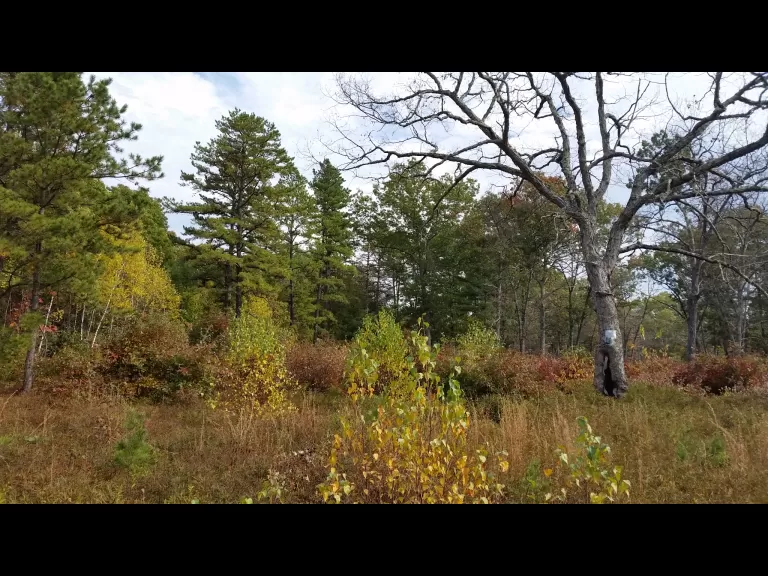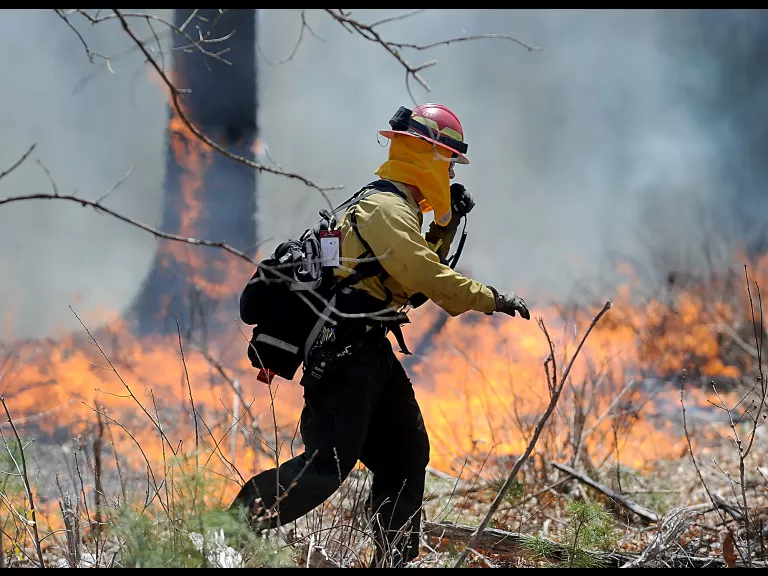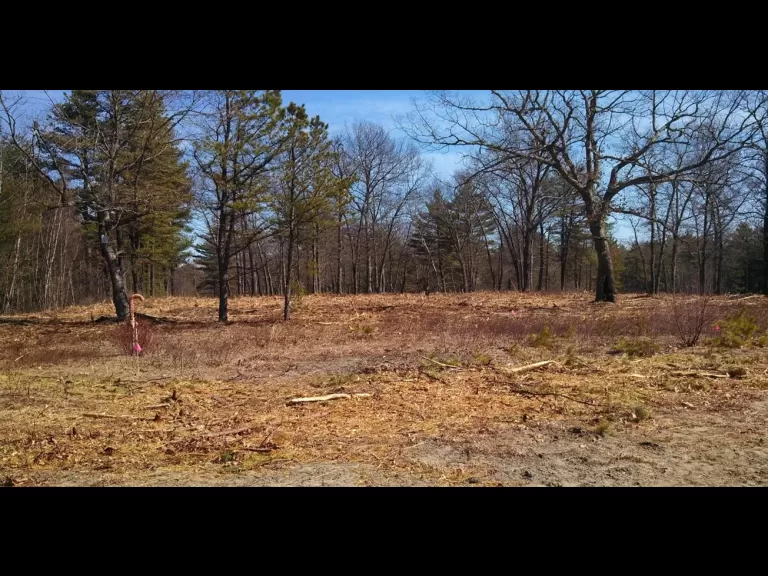Pitch Pine-Scrub Oak Barrens Restoration
At the Desert Natural Area, SVT and our conservation partners are restoring a globally rare habitat that supports rare species of birds, turtles, insects, and plants.
April 2025 Update
SVT and the City of Marlborough conducted a prescribed burn in the Desert Natural Area on Thursday and Friday, March 27 and March 28.
Want to learn more? We held an in-person/Zoom info session about the project on February 25. Watch a recording.
Located in Sudbury and Marlborough, the Desert Natural Area spans 900 acres of conservation lands that include SVT’s Memorial Forest, the City of Marlborough’s Desert Conservation Area, DCR’s State Forest Hanson Lot, and properties owned by several other entities. With an extensive trail network, the Desert is a popular destination for hikers, birdwatchers, and other nature lovers.
Habitats in the Desert Natural Area include pine-oak forest, cold-water streams, and marshes. The sandy, nutrient poor soils found in parts of the Desert also support a pitch pine-scrub oak barrens community that is unusual for this region and is among the most endangered ecosystems in the country.
Pitch pine-scrub oak barrens, which supports several rare and declining species of wildlife, need open tree canopies in order to thrive. Many of the plant and animal species in this community are adapted to fire and depend on occasional fire for their survival.
In recent decades, these barrens have greatly diminished across the northeastern U.S. due to development activity, the suppression of natural fires, the dominance of tall white pine and oak trees, and the prevalence of invasive species.
The owners of the conservation lands in the Desert Natural Area want to reverse this trend. By selectively cutting trees and re-introducing prescribed fires, we are engaged in a long-term project to rejuvenate the pitch pine-scrub oak habitat that supports the native diversity of the landscape.
In Phase I of the project, in partnership with the City of Marlborough, we conducted a prescribed burn in 2014 over 14 acres. In Phase II, SVT selectively cleared trees from about 50 acres to open up the canopy. In Phase III (winter 2023), the City of Marlborough selectively removed trees to open up the habitat on an additional 21 acres. SVT hired a contractor to clear firebreaks and to mow the 14-acre unit to prepare it for a prescribed burn.
In Spring 2025, SVT contracted with Star Tree Wildfire Protection LLC to conduct a prescribed burn. SVT and the City held two events to inform the public about the project:
- Tuesday, February 25, 7:00 – 8:30 p.m.: Public Information Presentation (Hybrid) at the Goodnow Library in Sudbury. Watch a recording of the Zoom presentation.
- Saturday, March 15, 9:30 a.m. to 12:30 p.m.: Public Site Walk.
See photos and more information.
(The Spring 2025 prescribed burn received grant funding from MassWildlife, the DuPont Clear Into the Future program, and Hollis Declan Leverett Memorial Fund, Bank of America, N.A., Trustee.)
Through biological monitoring, we are evaluating the success of our efforts and adapting our plans when necessary. Our monitoring includes an annual breeding bird survey, vegetation monitoring, insect surveys, vernal pool monitoring, and wildlife observations.
Ideally, we will restore 100 acres of this imperiled natural community, which is also targeted for protection in the Massachusetts Wildlife Action Plan. We anticipate that several rare and declining species of flora and fauna will benefit from the habitat restoration, including birds such as whip-poor-will, prairie warbler, Eastern towhee, and brown thrasher; insects such as barrens buck moth, frosted elfin (butterfly), slender clearwing (moth), and purple tiger beetle; plants such as wild lupine; and turtles such as the box and wood turtles.
Landowners in the Desert Natural Area
These landowners in the Desert Natural Area are cooperating in the effort to restore the pitch pine-scrub oak barrens habitat:
- SVT
- City of Marlborough
- Massachusetts Department of Conservation & Recreation (DCR)
- Town of Sudbury
- Assabet River National Wildlife Refuge (ARNWR)
- General Federation of Women’s Clubs of Massachusetts (GFWCM).
Ecological Goals of Project
The ecological goals for the restoration project are:
- Restore pitch pine-scrub oak barrens
- Control invasive species
- Enhance habitats for migratory bird species that are declining in population (such as eastern whip-poor-will, eastern towhee and brown thrasher)
- Maintain rare turtle habitat
- Maintain high quality cold water streams (Cranberry Brook and Trout Brook) that provide high-quality habitat to native brook trout and a diversity of macroinvertebrates.
- Maintain vernal pools and upland habitat required by vernal pool breeding amphibians.
The project partners also want to
- Maintain high-quality recreational opportunities [link to trail map, which also has trail policies]
- Preserve cultural and archeological resources
- Educate the public about the resources and management of the area.
Project Background and Timeline
Sudbury Valley Trustees, the City of Marlborough, and the DCR partnered with the Massachusetts Natural Heritage and Endangered Species Program (MNHESP) to implement this project. MassWildlife Burn Ecologists and MNHESP staff have provided extensive technical expertise and guidance.
Timeline
Ongoing
Since 2011, SVT and the City of Marlborough have used mechanical methods and selective herbicide applications to reduce the abundance and extent of invasive plants.
We regularly organize volunteers to conduct manual removal of invasive plants where appropriate. Anyone interested in participating is invited to contact SVT at [email protected].
March 2025
SVT and the City of Marlborough and SVT contracted with Star Tree Wildfire Protection LLC to conduct a prescribed burn over 75 acres on March 27 and March 28. To ensure the safety of wildlife, however, MassWildlife's Natural Heritage & Endangered Species Program required us to leave about 15 acres unburned to provide a refuge area for threatened species of moths and salamanders.
Our plan was to burn 30 acres on each of two days, but due to windy conditions on the second day, the Sudbury Fire Chief required us to conduct a burn with even higher levels of control and over a smaller (11-acre) area. Overall, we burned 41 acres over the two days.
February 2024
The City of Marlborough and SVT conducted mowing in previously burned areas and fire break clearing to prepare for a prescribed burn. The City also conducted a timber harvest on 21 additional acres to prepare for a prescribed burn.
January 2021
Great Oak Services mowed the 15-acre area around the Desert Loop Trail of SVT's Memorial Forest to create a layer of woody debris that will provide better fuel for a subsequent prescribed burn.
November 2020
SVT and MassWildlife's Burn Ecologists toured Memorial Forest and the Desert Natural Area to assess the site and make plans for the next prescribed burn. The Burn Ecologists were pleased to note an abundance of scrub oak as well as the presence of several plants that are characteristic of these types of barrens, such as Labrador Tea and pinweed.
March 2020
SVT and the City of Marlborough hired Northeast Forest & Fire Management, LLC, to prepare an updated Burn Plan for 56 acres on SVT's Memorial Forest and 8 acres on City of Marlborough's Desert Natural Area.
The Burn Plan was approved by MassWildlife for restoration of rare species habitat. The Massachusetts Department of Environmental Protection issued a burn permit, and both the Marlborough and Sudbury Fire Chiefs reviewed the plan and gave their support. An Order of Conditions was issued by the Sudbury Conservation Commission for work within and abutting wetland resource areas. Unfortunately, the burn was postponed due to the COVID-19 pandemic.
2017
Phase II clearing work at SVT's Memorial Forest was completed. The Phase II management area is located between the old rail line, Hop Brook and Cranberry Brook. Unit A, 15 acres, was heavily thinned (50%) in preparation for a prescribed burn. Unit B, 35 acres, was thinned and may be burned to improve ground level site conditions but no trees will be cut or harvested for at least another 10 years (see map).
2015 - 2016
SVT and the Town of Sudbury released tens of thousands of Galerucella beetles to control purple loosestrife in the marshes along Hop Brook. This insect from Eurasia feeds exclusively on purple loosestrife.
May 2014
Under the supervision of Joel Carlson, Northeast Forest & Fire Management, LLC, SVT and Marlborough implemented a prescribed fire on 14 acres located at the town boundary, on either side of the gas pipeline (trail intersection "E"). The burn was preceded by site preparation that included the mowing of shrubs and trees up to 6 inches in diameter.
2009 – 2010
The owners of the abutting lands agreed to cooperate on a restoration project. As a first step, we mapped invasive plant species and their distribution.
For More Information: FAQs
Forest Stewardship Plans
Several of the project partners prepared Forest Stewardship Plans in 2010. These plans laid the foundation for the subsequent management.
- Forest Stewardship Plan for SVT's General Federation of Women's Clubs of Massachusetts Memorial Forest
- Forest Stewardship Plan for The City of Marlborough's Desert Natural Area
- Forest Stewardship Plan for the Town of Sudbury's Hop Brook Conservation Area
- Forest Management Proposal for the Department of Conservation & Recreation Bureau of Forestry
Project Funding
This project has been supported by grants from:
- MassWildlife
- Hollis Declan Leverett Memorial Fund, Bank of America, N.A., Trustee
- DuPont Clear Into the Future
- The Sudbury Foundation
- Foundation for Metrowest
- National Fish & Wildlife Foundation’s Pulling Together Initiative
- USDA NRCS Environmental Quality Incentives Program (EQIP)
- Massachusetts Department of Conservation and Recreation Forest Stewardship Program


